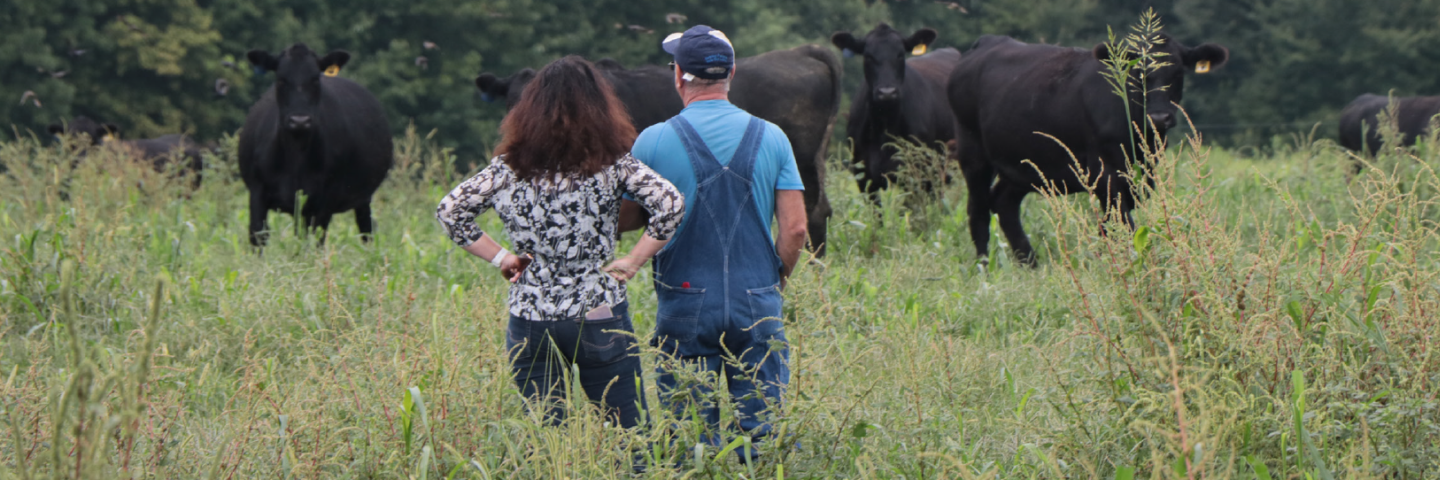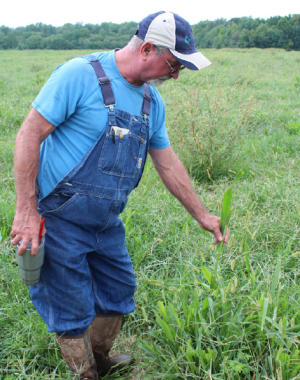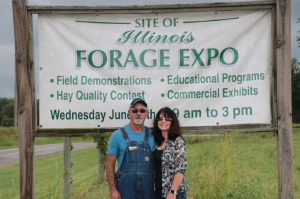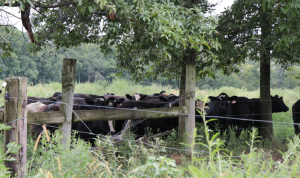
Two Careers; One Passion
Perry Hottes
Jefferson County, IL
Perry Hottes of Waltonville, Illinois spends five days a week working second shift, where he stands on a concrete floor at the Continental Tire Manufacturing Plant. But he spends every morning and his at-home “weekends” in a completely different environment. Of the two, Perry definitely prefers walking around outdoors among his grass-fed beef cows in beautiful, green pastures. Wouldn’t you?
Perry grew up on a grain and hog farm in Ava, Illinois. He owned 100 acres of land in Perry County but when he started working at the tire plant in Mt. Vernon, making that daily commute was just a waste of time and fuel. In 2003, he sold that ground, bought 145 acres in Jefferson County, and moved himself and his livestock over to Waltonville. Those acres were in USDA’s Conservation Reserve Program (CRP) for twenty years, but he had something else in mind. He had a plan for his second career; a plan that is very different from his first.

The tire plant provides steady income and health insurance, but it’s Perry’s other job he enjoys the most. What’s his other job and when does he find the time for it? Perry Hottes is a grass farmer, a land manager, and a livestock owner.
Since soil on the land he bought had been in grass for so long, it surprised Perry to see soil tests come back with rather poor ratings. No matter. Perry’s plans were to manage that land and use it like never been before. He had land. And he had livestock. When done correctly, that’s a perfect recipe for healthy soil and a successful and sustainable operation.
Hottes’s operation includes around 65 cow-calf pairs with two steers. Early on, he established fences on his pastures and in 2005 developed a rotational grazing plan with help from technical specialists at USDA’s Natural Resources Conservation Service (NRCS) and the Environmental Quality Incentives Program (EQIP).
“It takes land and a lot of capital to create a grass-fed beef operation,” Hottes says. “But with the right information, you can create something that works well for everyone involved.” By “everyone,” he means himself, his herd, his customers, and his land.
When adjacent land with a house on it came up for sale in April of 2005, Perry bought it and another 60 acres. His footprint and pasture options were expanding. He bought another 30 acres across town which he uses to grow and stockpile additional hay. The house was built in 1911 but Perry and wife Cary added a second level, made many updates and improvements, and made it home.
To build a truly sustainable grazing system, Perry worked with NRCS and local Soil Conservationist Jeremy Jackman to use both technical and financial assistance from NRCS’s EQIP to accomplish the following:
- Finalize the fencing system,
- Add watering facilities and Heavy Use Areas,
- Establish a Forage an Bio-mass planting,
- Build a Winter Feeding Station and Access Road,
- Define grazing paddocks, and
- Purchase necessary manure management tools.
When he’s not on the clock at his day job, Hottes stays busy managing water, fences, fertility, and genetics—all for livestock and for the pastures themselves. He also owns nearby timber and has trees to manage. “It’s a lot to take care of. And it can be amazingly complex. But it’s the best job I’ve ever had.”
Today’s conservation graizers must stay on top of new techniques and continually incorporate new strategies to keep up with a growing industry and an ever-changing environment. According to NRCS Soil Conservationist in Illinois, Jeremy Jackman, “There are always new tools and techniques to try, new ways to adapt. You have to be ready for last-minute changes and weather conditions.”
Perry’s newest additions, a Winter Feeding Station and Access Roads, have seriously changed conditions on his farm for the better. “It’s not always the big things that can drastically change conditions and problems you experience on a livestock farm. I’ve found that small changes have a huge impact. Little things can make a big difference for my cows and my day-to-day workload,” Hottes explains.

Although General Tire was bought out and renamed “Continental” decades ago, Perry held fast. He still spends 48 hours a week standing on the plant’s concrete floors as the Tandem Mixture Operator, overseeing the complex recipe of rubber and synthetic ingredients used to create rubber tires. Perry’s job at the plant is predictable, even mundane. His job growing grass and tending to the needs of cows, herds, and soil biology is anything BUT predictable.
“I enjoy the challenge of continually monitoring and adjusting all the different aspects of a grass-based livestock operation. There’s a lot to manage. And because you’re dealing with land, Mother Nature, weather, science, and biology? Well, you’ve got to be ready for anything.”
What helps is that Hottes uses a customized rotational grazing plan. Growing different grass and legumes and forage species is only part of the job. But it’s the most important part. Hottes needed help, guidance, and both technical and financial assistance to successfully establish the grass and get the infrastructure to create the system.
Until Hottes put rock down as part of his new access road, he never realized just how often he battled mud every single day. “The ease of moving our cows around, providing access to minerals and placing manure where I need it has simplified my life so much,” Hottes says.
Hottes’s current pasture mix includes friendly-endophyte tall fescue, orchard grass, ladino clover, and switchgrass as well as reed canary grass and Italian ryegrass. He’s also now mixing in Sudan grass, Pearl Millett, and sorghum Sudan. Native Bluegrass comes up all on its own. The mix seems to be working perfectly, as his fields and herds are looking great. Perry has several breeding cows who are 13 years old and still going strong.
Perry’s wife, Cary, is an integral part of the grazing operation. While Perry works second shift, Cary works days. That ensures someone is always on the farm and able to monitor what’s going on with the cows and the pastures. Cary is continually amazed by the level of know-how and expertise Perry has just to keep things running smoothly.
“Perry is always adapting to changing conditions,” Cary explains. “He keeps track of everything and makes adjustments along the way. He’s always trying something different, something new.” Although she is new to livestock farming, she enjoys living close to nature where she can enjoy the outdoors and live on land covered with beautiful, natural pastures.

EQIP and help from NRCS has been essential to Hottes’ success. Besides implementing his grazing plan, monitoring pastures, and using the Winter Feeding Station, Hottes added two ponds on the farm. With ample rain this summer—9 inches in one storm—the ponds remain full. Perry has already benefited from having his own water supplies when the Intercity Water Plant suffered a 48-hour shutdown from a broken 36” water pipe in May of 2018.
Hottes has learned a great deal about cows and grazing, and growing grass over the last twenty years. The health of his soil continues to improve. Healthy soils are able to absorb and infiltrate heavy rains and retain moisture if drought poses a threat. “Healthy pastures and healthy cows can handle anything nature throws at us,” Hottes adds. Hottes is always eager to share with others what he’s done and what he’s learned about pasture management over the years.
Perry organized several pasture tours and educational events, including the Illinois Forage and Grassland Council’s, 2018 Forage Expo. Perry also used NRCS’s EQIP, which offered up a chance to try new livestock options including mineral placement, manure deposits, and wildlife escape route for small critters who get ‘stuck’ in water tanks.
According to Roger Staff, an NRCS technical specialist who works with Hottes, “Perry has a great grass operation here. He’s used EQIP to get conservation practices installed and to help pay for big ticket items. But he’s also done a lot on his own. Perry is always willing to try something new and wants to help others learn what he learns.”
Besides modifying his pasture species, Perry works to improve his use of hay and his herd’s feed efficiency. He stockpiles fescue in the fall and uses a protein supplement for increased energy when he notices the herd needs it. At this point, he’s divided his acres into 18 paddocks and is always looking for new ways to make his system work better—better for the grass and better for the herd.
“I’d have to say that for a guy who is relatively new to grass-fed beef and grass management, Mr. Hottes has proved himself to be quite innovative,” Jackman said. “He finds the time to stay on top of new ideas and information and he’s willing to try out new ideas. He’s definitely a Conservation Graizer!”
And someday soon, he will say goodbye to his concrete floor job and spend more quiet mornings and long days out among the tall and lush grasses.
To learn how USDA’s NRCS can help your livestock operation or address natural resource concerns, call your local county office today. Visit Illinois NRCS to find the office closest to you.

